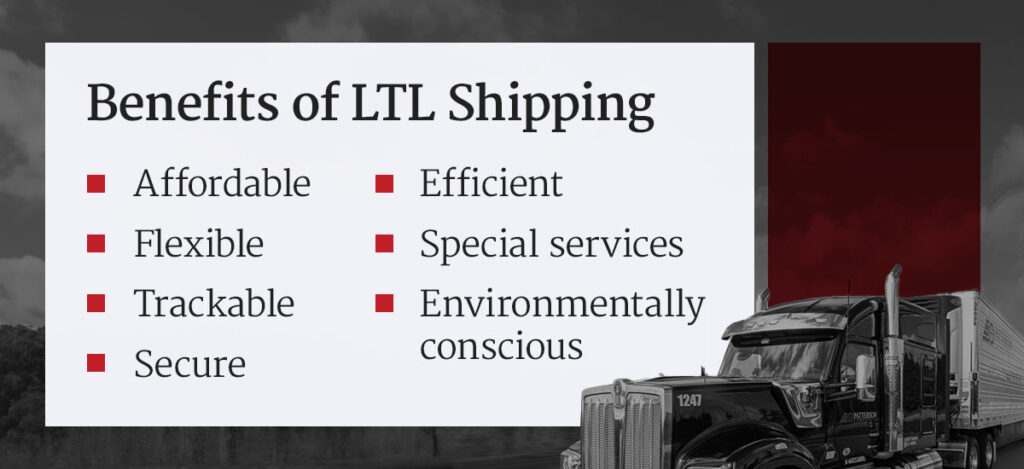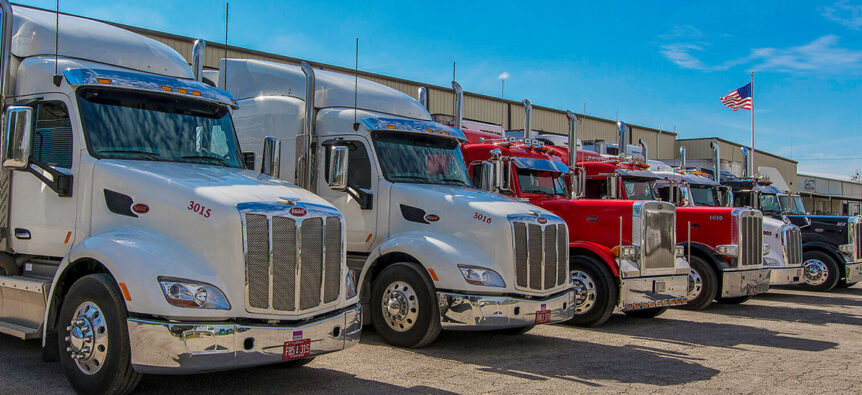Have you ever faced the dilemma of needing to ship a few pallets but not having enough product to fill an entire truck? You’re not alone. Less-than-truckload (LTL) is the shipping superhero you didn’t know you needed.
But what is less-than-truckload freight shipping? There’s no need to feel overwhelmed by shipping logistics — we’re here to break it down.
What Is LTL Freight Shipping?
Less-than-truckload shipping is a type of freight shipping used for small consignments. In other words, instead of paying for a whole truck, you share space with shipments from different businesses — think of it like carpooling for your shipments. Full truckload (FTL) shipments fill a whole truck. FTL is ideal for larger loads that must go to their destination without sharing space.
LTL is perfect for shipping furniture, auto parts, machinery, and food and beverages. LTL shipping is all about efficiency and cost savings — why rent the whole truck when you only need a portion?
How Does LTL Freight Work?
LTL freight shipping is a smart way to move goods without filling a whole truck. Imagine LTL shipping as a truckload jigsaw puzzle. Different shippers’ freight is organized into pieces that fit perfectly.
But how does this shipping method work? The general process involves:
Pickup
Your goods are picked up and taken to the local terminal. Here, they join other partial loads from various shippers, all heading in the same direction. Each shipper pays only for the space their goods occupy.
Sorting and Consolidation
Then, freight is sorted and consolidated based on its destination. This is where the puzzle analogy comes in. Freight brokers and carriers are the matchmakers here. They connect shippers with available LTL capacity. They handle rate negotiations, ensure timely deliveries, and offer carrier options.
Transportation
The consolidated load is then transported to another terminal closer to the final destination. Think of it as a relay race, with your shipment handed off smoothly.
Final Delivery
At the destination terminal, shipments are sorted again and delivered to their final destinations.
Your shipment is tracked throughout this process, so you always know where it is. LTL freight revolves around this efficient, cost-saving method. This method lets you share truck space and reduce costs without compromising reliability. So, it’s a win-win — your goods get where they need to go, and you save money!
Who Uses LTL Freight?
Businesses of all sizes can use LTL freight shipping — especially if they don’t need a whole truck. Here’s a list of those who commonly use LTL freight:
- Business owners who need to ship a few pallets of products
- Retailers sending inventory to various locations
- Manufacturers transporting components or finished goods
- E-commerce shippers managing customer orders
- Electronics companies shipping devices and parts
- Clothing and apparel brands moving garments
- Machinery and equipment suppliers distributing their products
- Automotive parts dealers sending parts to different outlets
Imagine you’re a small business owner who must send a few product pallets to different locations. Renting a whole truck would be overkill and too expensive. This is where LTL freight comes in handy. LTL freight allows you to transport smaller loads while taking advantage of expert freight services.
What Are the Benefits of LTL Shipping?
Here’s a rundown of the key advantages of LTL freight:

- Affordable: Since you share truck space with other shipments, you only pay for the part of the truck you use. This makes LTL shipping much more affordable than hiring a whole truck for smaller loads.
- Flexible: LTL freight is ideal for shippers with loads that don’t fill a whole truck. It allows you to ship anything from a single pallet to several.
- Trackable: LTL carriers provide tracking services, so you always know where your shipment is. They can use a bill of lading (BOL) number, progressive rotating order (PRO) number, or pickup date range as tracking methods.
- Secure: Pallets bundle LTL freight before it’s loaded onto a truck. Because it’s packaged into a single pallet, it is more likely to be safe in transit.
- Efficient: LTL carriers often have regular routes and schedules. This means you don’t have to wait to accumulate a full truckload, reducing delays.
- Special services: Many LTL carriers offer extra services. Some services include liftgate delivery, inside pickup and delivery, and residential delivery.
- Environmentally conscious: LTL freight helps reduce the number of trucks on the road. With fewer trucks, you can reduce emissions and your carbon footprint.
How to Ship LTL Freight
Shipping LTL freight might feel like a complex process, but breaking it down into steps can make it more manageable.
1. Prepare and Package
Package your goods by placing them on a pallet to protect them from damage, considering potential handling during transit. Use crates for added protection or wrap palletized goods securely.
2. Label Your Freight
Mark your freight with labels showing any special handling instructions, like “This Side Up” or “Fragile,” to ensure safe handling.
3. Get a Quote
Provide detailed information about your shipment to get accurate pricing from carriers. Rates depend on weight, dimensions, distance, and freight class. Freight class considers the item’s density, stowability, handling, and liability. Carriers will also likely ask for the following information:
- Description of your commodity
- Special requirements
- Zip codes of pickup and drop-off locations
- Preferred delivery timeframe
- Weight and dimensions
4. Book Your Load
Select a carrier based on your needs and budget. Of course, ensure they have experience with LTL freight and can meet your requirements.
5. Load Your Shipment
Now, it’s time to load your freight. Be sure to do so quickly to make the most of your money. Why? Governmental laws and regulations limit how long truck drivers are permitted to stay behind the wheel. This is known as “hours of service” (HOS). These rules state that a driver may only be “on duty” for 14 hours out of every 24.
Additionally, there can be a time limit, usually around 20 minutes, at both pickup and delivery before extra charges incur, so it’s important to keep this in mind when loading your freight.
6. Inspect Freight
Communication is essential. Inspect your freight for exterior damage when it reaches your consignee’s door. Before accepting the package, ensure your consignee notes any damage on the BOL.
Note that LTL shippers have nine months from the date of shipment delivery to submit a claim. So, speak with your recipient to ensure that damaged items are not accepted without being noted on the BOL. Be sure to report damage as soon as possible.
7. Keep Records
Keep the BOL for record-keeping purposes. It may be needed for accounting, future shipments, or filing claims.

Wrap up Your Shipping Worries With Patterson
So, there you have it — a quick dive into LTL freight shipping! When you need to ship furniture, auto parts, machinery, or food and beverages, Patterson has got you covered.
With our LTL shipping services, you can count on us to deliver your goods on time and in perfect condition. Ready to make your shipping as smooth as possible? Choose Patterson for reliable, cost-effective transportation solutions that keep your business rolling.
Request a quote online or contact us for more information. Let’s get moving together!

